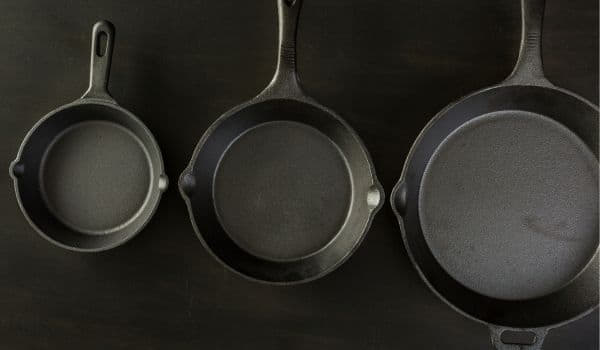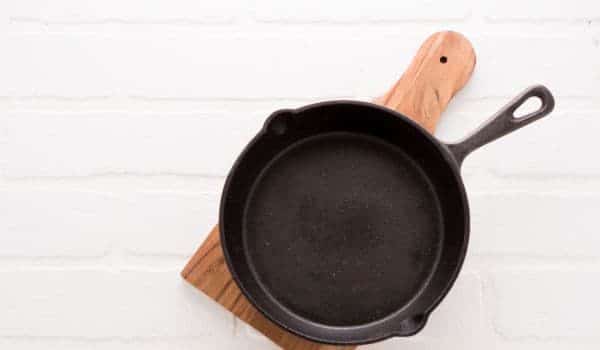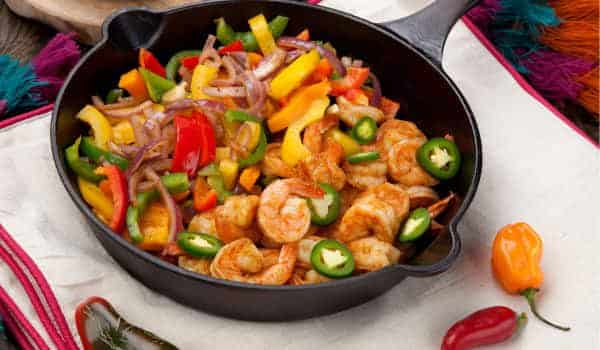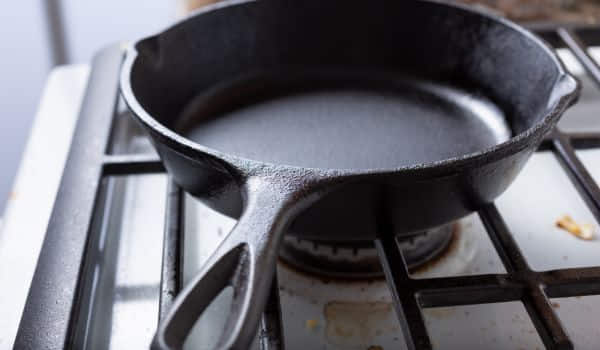Cast iron skillets have long been a staple in kitchens around the world, appreciated for their unique qualities and unparalleled performance. These versatile cookware items have earned their reputation as kitchen workhorses, with a wide array of benefits that cater to both novice and experienced cooks.
From their exceptional durability to flavor-enhancing properties, cast iron skillets have carved out a special place in the culinary world. In this exploration, we have delved into the various reasons why cast metal skillets are a cherished choice for many.
What are the key reasons for the exceptional durability of cast iron skillets?

The exceptional durability of cast iron skillets is primarily attributed to their robust material composition, which includes a high carbon content and a high melting point. This composition allows them to withstand high cooking temperatures without warping or deforming.
Additionally, their resistance to physical damage, such as impacts and scratches, makes them well-suited for high-traffic kitchens. Cast iron skillets can also endure harsh cooking conditions, including exposure to open flames and intense heat, making them a reliable and long-lasting choice for culinary enthusiasts.
What’s the best way to clean and maintain a cast iron skillet?

The best way to clean and maintain a cast iron skillet is to rinse it with hot water and gently scrub it using a soft brush or sponge, avoiding harsh abrasives or detergents. After washing, ensure it’s dried thoroughly to prevent rust. For routine maintenance, apply a thin layer of cooking oil and heat the skillet to maintain its seasoning.
In case of stubborn residues, a mixture of coarse salt and oil can be used for gentle scrubbing. These practices will help preserve the skillet’s non-stick surface and extend its longevity.
Durability

Cast iron’s resilience to wear and tear
Cast iron skillets exhibit remarkable resilience to wear and tear due to their robust material composition.
With a high carbon content and a melting point well above typical cooking temperatures, they can withstand the test of time. Their resistance to physical damage, including impacts and scratches, makes them an ideal choice for bustling kitchens and those with high foot traffic.
Furthermore, cast iron’s capacity to endure even the harshest cooking conditions, such as open flames and high heat, underscores their reliability, making them suitable for various culinary adventures, including outdoor cooking like camping and barbecues.
Longevity and potential for heirloom status
The longevity of cast iron skillets extends far beyond conventional cookware. These skillets boast an exceptional lifespan, often lasting for generations.
This extended lifespan translates to reduced expenses and less frequent replacements, making them a cost-effective choice. The seasoning process, where the skillet’s surface naturally becomes non-stick through the application of cooking oil and heat, not only enhances its durability but also safeguards against rust and corrosion.
What truly sets cast iron skillets apart is their potential to become cherished heirlooms. Passed down through families, they accumulate sentimental and culinary value, symbolizing tradition and timelessness in the kitchen.
In addition to their significance, cast metal skillets offer environmental benefits by reducing waste from disposable cookware, underscoring their role as a sustainable and enduring kitchen essential.
Heat Retention

Cast iron’s exceptional heat retention properties
Cast iron skillets are renowned for their exceptional heat retention properties. The unique material composition of cast iron, with its high heat capacity, allows these skillets to absorb and hold heat exceptionally well.
When heated, cast iron stores this energy, ensuring a consistent and even temperature across the entire cooking surface. This property makes cast metal skillets ideal for tasks that require prolonged and steady heating, such as searing, browning, or simmering.
As a result, they provide a more controlled and reliable cooking experience compared to cookware with lower heat retention capabilities.
Uniform heat distribution for cooking
In addition to their heat retention, cast iron skillets also offer uniform heat distribution for cooking. The even distribution of heat across the cooking surface prevents hot spots and cold areas, ensuring that food is cooked consistently.
This means that whether you’re frying, baking, or sautéing, your dishes will have an equal chance to be perfectly cooked, enhancing the quality of your culinary creations.
The combination of exceptional heat retention and even heat distribution sets cast iron skillets apart as versatile and reliable cookware, making them an essential tool for both amateur home cooks and professional chefs.
Versatility

Ability to use cast iron skillets on various cooking surfaces
Cast iron skillets are highly versatile due to their ability to be used on a wide range of cooking surfaces. Whether you have a gas, electric, or induction stove, a campfire, or even a grill, a cast iron skillet can adapt to the heat source.
This flexibility makes cast metal skillets an excellent choice for those who want a single piece of cookware that can be used in various settings.
Additionally, they can go from stovetop to oven without any issues, making them perfect for dishes that require a combination of cooking methods.
Compatibility with a wide range of cooking methods
The versatility of cast iron skillets also lies in their compatibility with a wide range of cooking methods. They are suitable for frying, sautéing, searing, and even baking.
The skillet’s ability to withstand high temperatures and its excellent heat retention and distribution make it an ideal choice for achieving a perfect sear on a steak, creating a golden, crispy crust on cornbread, or even making a deep-dish pizza.
This adaptability means that a cast metal skillet can replace several other pieces of cookware in your kitchen, simplifying your culinary tasks and expanding your cooking repertoire. Whether you’re preparing breakfast, dinner, or dessert, the cast iron skillet can handle it all with ease.
Flavor Enhancement
Seasoning process and flavor development
The seasoning process and flavor development in cast iron skillets are intrinsically linked. Through the seasoning process, a layer of polymerized oil forms on the skillet’s surface, creating a natural non-stick coating.
This seasoning not only prevents food from sticking but also enhances the flavor of the dishes cooked in the skillet. Over time, as you use the skillet, this seasoning layer absorbs and retains the flavors of the various ingredients cooked in it.
This accumulated seasoning adds depth and complexity to your dishes, creating a unique, rich flavor profile that can’t be replicated with other types of cookware.
Enhanced flavor profile of foods cooked in cast iron
The enhanced flavor profile of foods cooked in cast iron skillets is a hallmark of these versatile pans. The even heat distribution and exceptional heat retention properties of cast iron ensure that food is cooked uniformly, allowing for better caramelization and flavor development.
Whether you’re searing a steak, sautéing vegetables, or baking cornbread, the result is a deeper, more pronounced flavor in your dishes. Additionally, the seasoning layer on the skillet imparts a subtle, smoky undertone to the food, enhancing its overall taste.
This is why cast metal skillets are often favored for dishes like fried chicken, frittatas, and cornbread, where the unique flavor profile created by the skillet is an essential part of the culinary experience.
Health Benefits
Iron supplementation
Cast iron skillets offer a unique health benefit by acting as a source of dietary iron supplementation. When cooking with cast iron, a small but significant amount of iron can be transferred to the food.
This can be particularly advantageous for individuals who are at risk of iron deficiency or anemia. As the iron released from the skillet can contribute to their daily iron intake.
It’s a natural and gradual way to boost iron levels, especially for those who prefer to avoid iron supplements or have dietary restrictions that limit their metal absorption from other sources.
Reduced need for added fats and oils
Cooking with cast iron can lead to a reduced need for added fats and oils in your recipes. The natural seasoning that develops on the skillet’s surface not only enhances flavor but also acts as a non-stick coating.
This non-stick property allows you to cook with less oil or butter, reducing the overall fat content of your dishes. This can be beneficial for those looking to reduce their calorie intake or lower their fat consumption for health reasons.
Moreover, it promotes a healthier cooking method. Making it an appealing choice for those interested in preparing meals with a lower fat content while still enjoying the benefits of non-stick cooking.
Cost-Effective
Long-term savings compared to non-durable cookware
Cast iron skillets offer significant cost savings over the long term compared to non-durable cookware. While the initial investment in a cast iron skillet might be slightly higher than some other types of cookware.
Their exceptional durability ensures they outlast many cheaper alternatives. Instead of needing frequent replacements or upgrades, a well-maintained cast metal skillet can last for generations.
This longevity translates into lower overall costs as you won’t have to continuously purchase new pans. Making it a smart financial choice for home cooks and professional chefs alike.
Value for money given the skillet’s longevity
The value for money provided by cast iron skillets is undeniable, thanks to their remarkable longevity. Their initial cost becomes a wise investment when you consider the number of meals and years of use you’ll get from a single skillet.
This long-lasting cookware is designed to endure the test of time, offering consistent and reliable performance. When you factor in the potential for these skillets to become cherished heirlooms, passed down through generations.
Their value appreciates over time. The combination of exceptional durability and the potential for sentimental and culinary significance makes cast iron skillets a truly cost-effective choice for those looking to get the most out of their cookware investment.
Low Maintenance
Easy cleaning and care instructions
- Clean with hot water and a stiff brush or non-abrasive sponge
- Can withstand gentle scrubbing if needed
- Resistant to odors and flavor retention from previous meals
- Minimal effort and time required for routine cleaning
The simplicity of maintenance and seasoning
- The seasoning process enhances non-stick surfaces and prevents rust
- Easy to perform at home with basic supplies
- No need for specialized cleaning agents or complex care instructions
- Minimal effort and resources are required to maintain and extend the skillet’s lifespan
Iconic Aesthetics
Aesthetic appeal and nostalgia associated with cast iron
Cast iron skillets are celebrated for their aesthetic appeal and the nostalgia they evoke. Their appearance is timeless, characterized by a rich, dark patina that tells the story of countless meals and generations of cooks.
In today’s fast-paced world, they offer a charming link to the past, reminiscent of classic, vintage kitchens where generations of family members have gathered around home-cooked meals.
Beyond their utilitarian role, cast metal skillets are often used to serve dishes directly from the stove to the table, adding a touch of rustic elegance to the dining experience. Their beauty is not lost on hosts and hostesses.
As they can also serve as attractive centerpieces, enhancing the overall presentation of the meal.
Role in traditional and modern kitchens
Cast iron skillets have a remarkable ability to bridge the gap between traditional and modern kitchens. They seamlessly fit into both kitchen styles, adapting to the needs of today’s home cooks while preserving a sense of heritage and craftsmanship.
In traditional kitchens, they are a reassuring presence, evoking the warm, familiar feeling of home-cooked meals. In modern, minimalist kitchens, they serve as functional, versatile decorations, blending practicality with aesthetics.
This versatility is not limited to appearance; it extends to their use in a variety of cooking methods. Making them a cornerstone of both traditional and contemporary culinary landscapes.
Conclusion
In the realm of cookware, cast iron skillets stand as a timeless icon of culinary craftsmanship. Their unique combination of qualities, including exceptional durability, outstanding heat retention, and remarkable versatility, sets them apart from other pans.
The seasoning process that enhances their non-stick surface not only simplifies cooking but also imparts a distinct and delightful flavor to dishes.
Furthermore, cast metal skillets offer unexpected health benefits through iron supplementation and reduced need for added fats and oils. Their cost-effective nature, low-maintenance requirements, and iconic aesthetics only add to their appeal.




